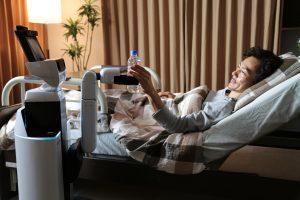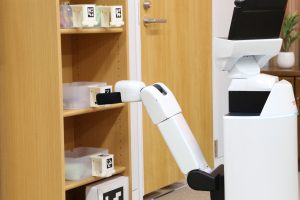Toyota Accelerates Home Helper Robot Programme With New Developer Community And Working Prototype
Toyota is accelerating development of a robot that can perform tasks in the home to help elderly and disabled people lead independent lives.
The Human Support Robot (HSR) is its response to the rising demand for long-term elderly care. The World Health Organisation predicts that by 2050, 22 per cent of the world’s population will be over 60 years old.
The HSR is compact and highly manoeuvrable, with a lightweight, cylindrical body and a folding arm. It can pick up objects off the floor, reach things down from shelves and perform a variety of other tasks.
Toyota is teaming up with a number of research bodies to set up the HSR Developers’ Community, making a combined effort to hasten development and early practical adoption of the HSR.
Artificial intelligence is not yet a substitute for human care, but the HSR will be able to be operated remotely by family and friends, with the operator’s face and voice being relayed in real-time. This will allow for genuine human interaction as the HSR goes about its work.
Toyota first announced its HSR programme in 2012, since when the robot has undergone a number of improvements, based on feedback from patients and healthcare workers. It will now be providing HSRs on loan to partner organisations in Japan, principally universities, research facilities and businesses. These will share their progress in software development and practical know-how with the development community. Toyota will also help research bodies by finding appropriate facilities for testing the HSR and providing other forms of support.
Initially, from September, the HSR Developers’ Community will consist of Toyota and several other institutions that are already involved in HSR testing. It hopes to increase membership to around 10 groups from April 2016 onwards, with applications to join now being accepted in the first round of recruitment.
As part of its efforts to kick-start HSR innovation, Toyota is hosting a “Hackathon” at its Mega Web showroom in Tokyo from 31 August to 2 September, in which eight teams will compete to develop the most innovative application for the HSR. The winners will receive an HSR development kit for a year, free of charge.
Human Support Robot specifications
| Body diameter (mm) | 430 |
| Body height (mm) | 1.005 – 1,350 |
| Weight (kg) | approx. 37 |
| Shoulder height (mm) | 340 – 1,030 |
| Object-holding capability | Weight up to 1.2kgWidth up to 130mm |
| Max. speed (km/h) | 0.8 |
| Mobility | HSR can move over surfaces with height difference up to 5mm and inclines up to 5° |
ENDS
Note to editors: Toyota’s Partner Robot Division was founded in 2005 to focus on the development of robots that exist in harmony with people, assisting in their activities and mobility. We view our Partner Robots as helpful, resourceful and intelligent machines. Partner Robot development is progressing in four areas: nursing and healthcare, short-distance personal transport, manufacturing, and home-living.





